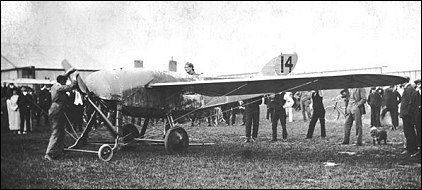| Leandro, e-mail, 03.03.2011 17:40 The Romanian aircraft designer Henri Coandă joined the Bristol in January 1912. His first design for Bristol was a two-seat monoplane trainer, a development of the Bristol Prier Monoplane, controlled by wing warping. The first prototype flew in March 1912.[1] A series of similar aircraft followed with both tandem and side-by-side cockpits, known as the School Monoplane and the Side by Side Monoplane.
A more powerful derivative was built for a competition to provide aircraft for the British War Office. Two aircraft, known as Competition Monoplanes were built and entered into the competition, together with two Bristol Gordon England biplanes. The aircraft were flown by Harry Busteed, Bristols test pilot and James Valentine.[2]
These did well in the competition, rated equal fifth and described at the time as "well-designed and well-constructed" though criticised as "heavy for the wing area" and lacking in power.[3] This resulted in their being purchased by the War Office for use as trainers by the Royal Flying Corps.[1] These two aircraft formed the basis for a revised military trainer, the Military Monoplane, which had increased wingspan.
The Military Monoplane later formed the basis for the Bristol TB.8, several being rebuilt into TB8s.
[edit]Operational history
The first School and Side by Side monoplanes entered service with flying schools operated by Bristol at Larkhill and Brooklands. One tandem and two side-by-side machines were sold to Italy, with four tandem and three side-by-side aircraft being sold to Romania.
The two Competition Monoplanes were purchased by the War Office after the Military Aircraft Competition, being used as trainers for the RFC. However, on 10 September 1912, one of the Competition Monoplanes crashed, killing Lts. E. Hotchkiss and C.A. Bettington.[4] While this was traced to one of the bracing wires becoming detached, it resulted in a five month ban of flying of all monoplanes by the military wing of the RFC.[1]
Despite this ban, Military Monoplanes were purchased by Romania and Italy, with a production license being granted to Caproni (although this license was later cancelled, only two being built by Caproni).[1] reply |











